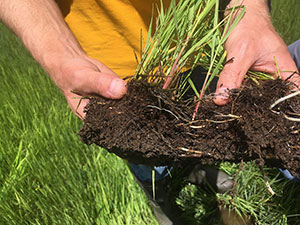
Contact Us
Institutional Communications
Bureau of Mines Building, Room 137
Laramie, WY 82071
Phone: (307) 766-2929
Email: cbaldwin@uwyo.edu

UW Project Seeks to Glean Factors Limiting High
Published March 29, 2021

Nonnative grasses take over hay meadows, forming a dense organic layer that ties up
nutrients in forms not available for plant uptake. (Jay Norton Photo)
University of Wyoming researchers will study soil health and factors that limit yield in high-elevation irrigated hay meadows on 12 ranch sites in Wyoming and Colorado as part of a $500,000 U.S. Department of Agriculture grant.
“This is a very cool project that we’re excited about,” says Jay Norton, a UW Extension soils specialist, who is heading the project.
The sites are in the Laramie River Basin in Wyoming and the North Park Valley in northern Colorado. The project began in January and will run through 2024.
Norton, a professor in the UW Department of Ecosystem Science and Management, says irrigated meadows above 6,500 feet are critical -- but underperforming components -- of livestock operations in rangeland ecosystems.
“We think it’s important because flood-irrigated grass hay is one of the most widespread crops in Wyoming, and producers agree that hay meadows are generally an underperforming resource that requires more and more nitrogen fertilizer to maintain productivity over time,” Norton says.
Norton leads a group of researchers from UW, including Mengqiang Zhu and Linda van Diepen, in the Department of Ecosystem Science and Management; Urszula Norton, from the Department of Plant Sciences; and Brian Sebade, a UW Extension educator; and Joe Brummer, a forage specialist at Colorado State University. Former UW students Daniel Adamson, from a ranch outside Laramie, and Rael Otuya, from Kitale, Kenya, have both returned to earn their Ph.D.s in soil science and are working on the project.
The scientists set four objectives.
First, they will evaluate soil processes and vegetation that affect nitrogen availability. This includes looking at soil health indicators; analyzing soil organic matter chemical composition; and soil microbial ecology and soil greenhouse gases. The information helps set the second objective, which is identifying key soil properties as a minimum dataset for meadow health.
The third goal will take place at the Laramie Research and Extension Center.
“We will evaluate novel ways to disturb the dense root mat using hoof impact from controlled cattle concentration and light shallow rototilling, before then planting a mixture of clovers to increase diversity and forage value,” Norton says.
The fourth goal, which includes exchanging information among researchers, producers, extension educators and others, entails monthly meetings with cooperating ranchers and annual progress meetings that will be open to the public, he says.
“Participants will be invited to participate in data collection activities, plus an end-of-project workshop to share findings and discuss new management approaches,” Norton says.
For more information, call Norton at (307) 766-5082 or email jnorton4@uwyo.edu.
Contact Us
Institutional Communications
Bureau of Mines Building, Room 137
Laramie, WY 82071
Phone: (307) 766-2929
Email: cbaldwin@uwyo.edu

